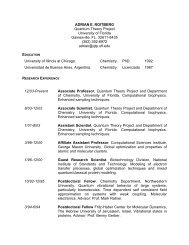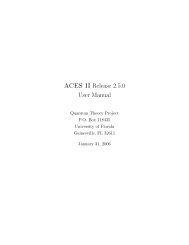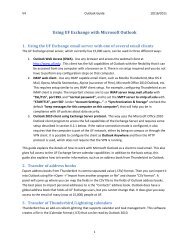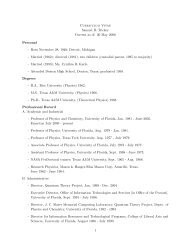Generalized-gradient-approximation noninteracting free-energy ...
Generalized-gradient-approximation noninteracting free-energy ...
Generalized-gradient-approximation noninteracting free-energy ...
Create successful ePaper yourself
Turn your PDF publications into a flip-book with our unique Google optimized e-Paper software.
KARASIEV, SJOSTROM, AND TRICKEY PHYSICAL REVIEW B 86, 115101 (2012)<br />
ν(t)<br />
2.5<br />
2<br />
1.5<br />
1<br />
0.5<br />
0<br />
0.01 0.1 1 10<br />
FIG. 12. ν(t) as defined by Eq. (B2).<br />
satisfactory results. In the T → 0 limit, all ftGGA <strong>free</strong> <strong>energy</strong><br />
functionals should reduce to known zero-temperature kinetic<br />
<strong>energy</strong> functionals, a fact we have used to present a rather<br />
simple ftGGA.<br />
Numerical implementation of the OF-DFT calculations in<br />
a plane-wave basis requires a local pseudopotential which we<br />
have presented. Comparison of finite temperature OF-DFT<br />
and KS calculations on sc-H over a wide range of material<br />
densities for electronic temperatures up to 100 000 K leads to<br />
the conclusions that two ftGGA functionals, namely KST2<br />
and VWTF, provide the overall best results and that the<br />
relative error in the high density regime is small for all<br />
functionals.<br />
ACKNOWLEDGMENTS<br />
We acknowledge informative conversations with Frank<br />
Harris and Jim Dufty with thanks. This work was supported<br />
in substantial part by the US Dept. of Energy TMS Grant No.<br />
DE-SC0002139.<br />
APPENDIX A<br />
The temperature scaling function κ introduced in Eq. (16)<br />
may be written by use of Eqs. (9) and (15) as<br />
t<br />
) −5/3<br />
κ(βμ) = 5 ( 3<br />
2 2 I 1/2(βμ)<br />
[<br />
× − 2 ]<br />
3 I 3/2(βμ) + βμI 1/2 (βμ) . (A1)<br />
By use of Eq. (14), we may eliminate (βμ) infavoroft<br />
in Eq. (A1). We have done that numerically. With that result,<br />
we can present κ(t) analytically as an adapted form of Perrot’s<br />
<strong>free</strong> <strong>energy</strong> fit. 16 See below. The functions ζ (t) and ξ(t) may<br />
be calculated using relations with κ(t) giveninEqs.(18)<br />
and (19). In addition, we provide an adapted analytical ˜h(t).<br />
Both functions are split into regions t t 0 and t t 0 , where<br />
t 0 = 4(2/3π 2 ) 1/3 /3, to take account of the different asymptotic<br />
forms of the Fermi integrals for (βμ) ≪ 0 and (βμ) ≫ 0.<br />
For t t 0 = 0.543010717965,<br />
κ(t) =−2.5t ln(t) − 2.141088549t + 0.2210798602t −0.5<br />
+ 0.7916274395 × 10 −3 t −2 − 0.4351943569<br />
× 10 −2 t −3.5 + 0.4188256879 × 10 −2 t −5<br />
− 0.2144912720 × 10 −2 t −6.5 + 0.5590314373<br />
× 10 −3 t −8 − 0.5824689694 × 10 −4 t −9.5 (A2)<br />
˜h(t) = 3 − 0.7996705242t −1.5 + 0.2604164189t −3<br />
− 0.1108908431t −4.5 + 0.6875811936 × 10 −1 t −6<br />
− 0.3515486636 × 10 −1 t −7.5 + 0.1002514804<br />
× 10 −1 t −9 − 0.1153263119 × 10 −2 t −10.5 . (A3)<br />
For t t 0 = 0.543010717965,<br />
κ(t) = 1 − 4.112335167t 2 + 1.995732255t 4 + 14.83844536t 6<br />
− 178.4789624t 8 + 992.5850212t 10 − 3126.965212t 12<br />
+ 5296.225924t 14 − 3742.224547t 16 (A4)<br />
˜h(t) = 1 + 3.210141829t 2 + 58.30028308t 4 − 887.5691412t 6<br />
+ 6055.757436t 8 − 22429.59828t 10 + 43277.02562t 12<br />
− 34029.06962t 14 .<br />
APPENDIX B<br />
(A5)<br />
We outline a route to simplified GGAs which is a potential<br />
alternative to the one given in the discussion of Eqs. (37)–(39).<br />
Equations (37) obviously combine to give<br />
Fσ SGA (s σ ) = 2 + 5 (<br />
s<br />
2<br />
27 τ − sσ 2 )<br />
− F<br />
SGA<br />
τ (s τ ). (B1)<br />
As suggested in the discussion in conjunction with Fig. 2, the<br />
ratio<br />
ν(t) := [s σ (t)/s τ (t)] 2<br />
(B2)<br />
is a smooth, bounded [0 ν(t) 2.2] function. See Fig. 12.<br />
With this function, Eq. (B1) becomes<br />
F SGA<br />
σ (s σ ) = 2 + 5<br />
27 s2 τ<br />
[1 − ν(t)] − F<br />
SGA<br />
τ (s τ ). (B3)<br />
Utilization to form a GGA is via<br />
Fσ GGA (s σ ) = 2 + 5<br />
27 s2 τ [1 − νGGA (t)] − Fτ GGA (s τ ), (B4)<br />
where the superscript “GGA” on ν indicates use of some<br />
judiciously selected approximate representation of ν(t). This<br />
choice can be constrained by insertion of the form from<br />
Eq. (B4) in Eq. (35). We have this approach under study.<br />
* vkarasev@qtp.ufl.edu<br />
1 N. D. Mermin, Phys. Rev. 137, A1441 (1965).<br />
2 M. V. Stoitsov and I. Zh. Petkov, Ann. Phys. 184, 121 (1988).<br />
3 R. M. Dreizler, in The Nuclear Equation of State, Part A, edited<br />
by W. Greiner and H. Stöcker, NATO ASI Vol. B216 (Plenum,<br />
NY, 1989), p. 521.<br />
115101-10








